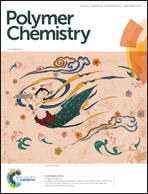Enzymatically crosslinked hydrogels based on linear poly(ethylene glycol) polymer: performance and mechanism†
Abstract
In the present work, a horseradish peroxidase (HRP)-catalyzed hydrogel based on a double-end tyramine conjugated linear poly(ethylene glycol) (TA-PEG-TA) polymer is developed. The TA-PEG-TA is designed to act as not only a substrate of HRP, but also a macromonomer. We find that, the linear structure is sufficient to form robust hydrogels, and therefore it greatly simplifies the polymer architecture applicable to HRP-catalyzed hydrogels, which are always based on graft or branched polymers. The gelation time and strength of the TA-PEG-TA hydrogels can be well tuned by varying the concentrations of the polymer and HRP as well as the molar ratios of H2O2 to TA groups. The gelation mechanism is clarified by exploring the HRP-catalyzed reaction of a single-end tyramine conjugated poly(ethylene glycol) monomethyl ether (mPEG-TA). The multiple active hydrogen atoms (in the hydroxyl group and the o-position) of phenol moieties can be oxidized by H2O2via HRP catalysis, which should be responsible for the generation of mPEG-TA oligomers and the gelation of TA-PEG-TA. This study provides a new strategy for the design of injectable enzymatically crosslinked hydrogels.



 Please wait while we load your content...
Please wait while we load your content...